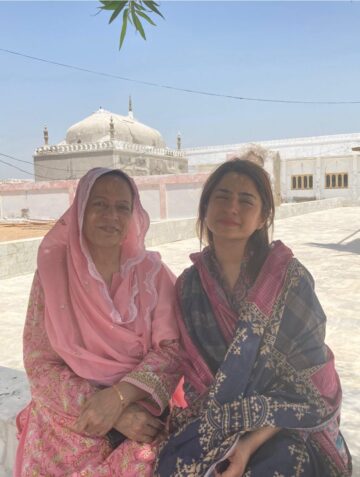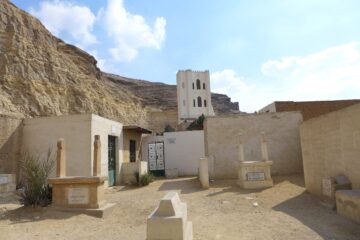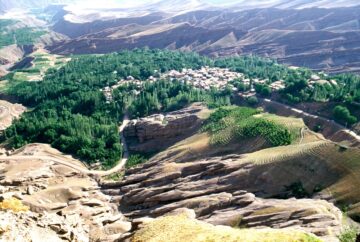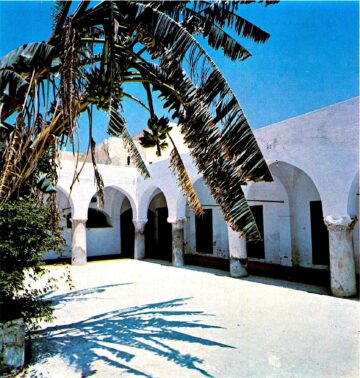The only passageway to the west from Damascus, al-Rabwa gorge was a strategic corridor and focus for all who ruled over Damascus.
Several important archaeological buildings are located atop the mountain overlooking the corridor — the dome of al-Sayyar from the Mamluk period, itself built upon an astronomical observatory constructed in 829 (during the reign of the Abbasid al-Maʾmun), several mosques from the Fatimid period, a Zanki-era palace, and a Mamluk-period shrine.
Also above al-Rabwa gorge, atop a high outcrop rising 40 m above the surrounding ground is Sakhrat al-Minshar (Saw Rock) as it is called by Damascenes, who also refer to it as Sakhrat al-Uzkurini (Remember Me Rock).
The inscription at Sakhrat al-Minshar dates back to 444/1052. It is a striking remnant of Ismaili heritage, providing archaeological evidence of the presence of IsmailisAdherents of a branch of Shi’i Islam that considers Ismail, the eldest son of the Shi’i Imam Jaʿfar al-Ṣādiq (d. 765), as his successor. at this strategic thoroughfare for Damascus during the time of the Fatimid Ismaili Imam-Caliph al-Mustansir bi’llah (r. 1036-1094).
Although part of the rock bearing the inscription was destroyed as a result of the construction of a road in 1859, the text of the inscription is recorded in the Répertoire Chronologique d’Epigraphie Arabe, published in 19361. Compressed sand, which had affected the surface of the inscription was cleaned off in 2010.
Ten lines in Kufic script are engraved into the rock. As re-examined by Ahmad Ibesch in 2016, and translated into English by Yasser Tabaʿa, it mentions the name of Imam al-Mustansir bi’llah and the construction of three mosques in the al-Rabwa village2:
- There is no God but God alone with no partner.
- Muhammad is God’s Prophet, ʿAli is God’s trustee, may God bless them and their pure family,
- ancestors of our Lord al-Imam al-Mustanṣir bi’llah, the Commander of the Believers,
- may God bless him and all of them. This rabwa was rebuilt and the three mosques
- in it were constructed according to God’s will by Abu al-Barakat Yahya b. Muḥammad b. Sala….
- bin abi Kharija the scribe. And he endowed it with this piece [of land]
- beneath them and two shops in the city of Damascus in the upper section of al-Sarrajin,
- located behind the Mosque al-Taraʾifiyyin, in the ardent desire that God will recompense him
- …for this endowment, which is restricted until the Day of Judgement, My [God] have mercy
- and liberate him from Hell. This was written in the year 444[1052].
Footnotes
- Répertoire Chronologique d’Epigraphie Arabe, ed. J. Sauvaget Combe and G. Wiet. (Cairo, 1936), no. 2560, pp. 101-102.
- Ahmad Ibesch. On Facebook, https://is.gd/Ibesch, 16 Feb 2016.
References
Combe, J. Sauvaget and G. Wiet, (eds.) Répertoire Chronologique d’Epigraphie Arabe. Cairo, 1936.
Source, CRediTs, and Acknowledgements
SYR0024S – Al-Rabwa Inscription. Ismaili Heritage Database. Ismaili Heritage Project, The Institute of Ismaili Studies, 2023.
Haytham Hasan: Investigation, Writing – Original Draft; Sorbon Mavlonazarov: Validation, Visualisation, Data Curation, Writing – Review and Editing; Maryam Rezaee: Validation, Visualisation, Data Curation, Writing – Review and Editing; Fayaz S Alibhai: iConceptualisation, Methodology, Validation, Writing – Review & Editing, Visualisation, Supervision, Project Administration; Najam Abbas: Writing – Review & Editing; Shiraz Allibhai: Conceptualisation; Nazir Mulji: Conceptualisation; Zayn Kassam: Conceptualisation; Abdul Javery: Software, Data Curation; Shoaib Momin: Software, Data Curation; Javed Merchant: Software, Data Curation; Nuresh Momin: Software, Data Curation.
About
The Ismaili Heritage Project is a tripartite collaboration between IIS (London), the Aga Khan Trust for Culture (Geneva), and the Department of Jamati Institutions (Lisbon). The project aims to document, protect, conserve, and celebrate the built and other associated heritage of the global Shia Ismaili Muslims.








